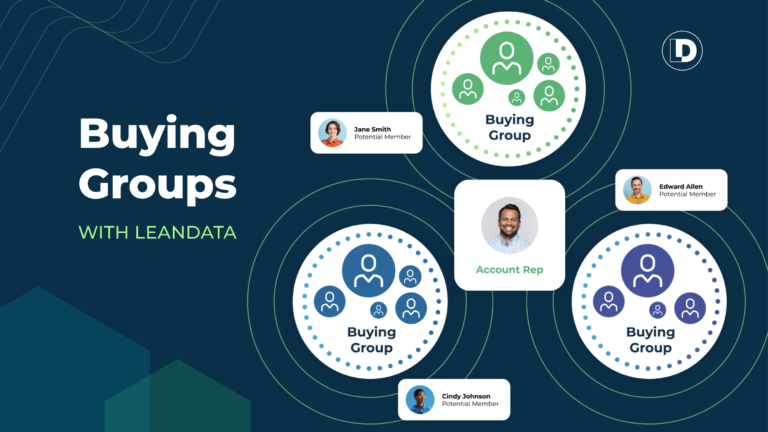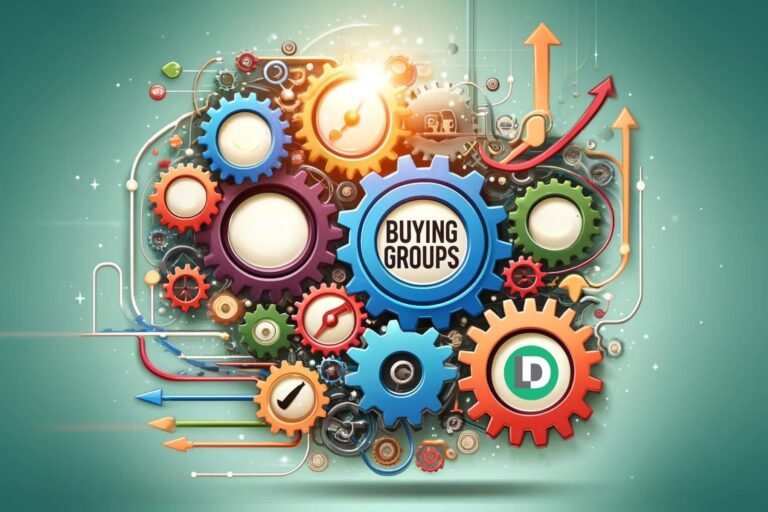The Strategic Advantage of Buying Groups
In the complex landscape of B2B sales, decision-making processes are multifaceted and highly collaborative. That’s why the ability to understand the dynamics of Buying Groups is a critical strategic advantage.
Forrester defines Buying Groups as collections of stakeholders from various functions within an organization who collectively play a critical role in making purchasing decisions.
These groups may include members from IT, finance, operations, and other key areas. Each bring their specific priorities and concerns to the decision-making table.
The significance of Buying Groups in B2B sales cannot be overstated.
They represent a shift from traditional, linear sales approaches that typically target individual decision-makers. Instead, focusing on Buying Groups is a holistic strategy that addresses the collective needs and concerns of every stakeholder involved in the purchasing process.
This shift is driven by the increasing complexity of products and solutions. It also recognizes that purchases can have wide-reaching impacts across an organization.
As such, Buying Groups are now central to modern sales strategies. Sales and marketing teams must adapt their approaches to engage multiple influencers and decision-makers effectively.
Transforming Sales Approaches for Buying Group Engagement
Using advanced analytics and comprehensive data management tools, companies can transform their approach to Buying Group engagement from a generalized and often speculative effort to a precise and informed strategy.
First, this increases the efficiency of sales processes. But more importantly, it boosts the likelihood of closing deals by ensuring that all stakeholders in the Buying Group feel understood and valued.
This article aims to equip revenue operations leaders and C-suite executives with the knowledge and tools to navigate the dynamics of Buying Groups. The ultimate goal being turning potential challenges into opportunities for growth and success.

Understanding the Dynamics of Buying Groups
Buying Groups represent a sophisticated network of decision-makers and influencers from various departments and hierarchical levels.
Each member of a Buying Group plays a distinct role. They contribute their unique priorities, perspectives, and influences to the collective decision-making process.
These roles range from end users who will directly interact with the product, to IT staff concerned with integration and security. Not to mention, there are senior executives focused on strategic implications and ROI.
The diverse makeup of these groups introduces a multi-dimensional challenge for sales and marketing teams.
It is not just about identifying who the decision-makers are, but also understanding the motivations and concerns of each member:
Role Identification
Each member of the Buying Group has a specific role that defines their interest in the purchase. For example, a CFO will be interested in cost implications and ROI. In contrast, a CTO will evaluate technical compatibility and scalability.
A seller’s sales and marketing teams need to identify these roles accurately to tailor their messages effectively.
Prioritization of Needs
The needs and priorities of each group member can vary significantly. In fact, they sometimes conflict. For instance, while the IT department might prioritize security features, the marketing department might focus on ease of use and functionality.
Understanding these priorities helps in crafting proposals that address multiple viewpoints and facilitate consensus within the group.
Influence and Power Dynamics
Not all members of the Buying Group have the same level of influence over the purchasing decision. Some may have veto power, while others may serve more as advisors.
Mapping out the power dynamics within the group is crucial for focusing efforts on the most influential members. At the same time, it’s important to address the needs and concerns of the advisors who can sway decisions.
Communication Styles and Preferences
Different stakeholders often prefer different methods of communication and levels of detail in the information they receive. Technical stakeholders may prefer detailed product specifications and data sheets.
However, executive members may favor high-level summaries that focus on business outcomes and ROI. Adapting communication styles to match these preferences is key to maintaining engagement across the group.
Strategic Alignment of Sales and Marketing
Navigating these complex interactions requires a strategic alignment of sales and marketing efforts. It’s important to not only meet, but also anticipate the collective needs of the group. This involves a continuous process of engagement. Information should not be merely presented, but exchanged in a way that addresses concerns, and answers questions.
Engagement should focus on building a compelling case for the product or solution. The overarching goal is to create a unified strategy that encapsulates the diverse needs of the Buying Group. It should ensure that every interaction moves the group closer to a consensus decision.
Sales and Marketing Agility
This strategic approach emphasizes the importance of agility and responsiveness. Do not be surprised if the dynamics within Buying Groups evolve throughout the sales cycle.
Sales and marketing teams must be equipped to adapt their strategies in real-time. This means responding to new information and shifting priorities within the group.
Effective management of these dynamics not only enhances the likelihood of a successful sale but also builds a foundation for long-term relationships with each department and stakeholder involved. This fosters trust and opens doors for future opportunities.

Strategic Engagement of Buying Groups
The strategic engagement of Buying Groups requires a nuanced approach tailored to the unique structure and dynamics of each group. Your tech stack needs to facilitate this process, enabling sales and marketing teams to engage these groups more effectively:
Precise Identification and Role Clarity
Advanced lead-to-account matching technology is instrumental in the precise identification of Buying Group members and clarifying their roles within the organization.
This technology sifts through data to associate leads with the correct accounts and identifies the specific roles individuals play within their Buying Group. Understanding these roles is crucial for developing targeted engagement strategies that are relevant to each member’s responsibilities and influence within their organization.
For example, messaging to a CTO would focus on technological benefits and integration capabilities, whereas communication with a CFO would emphasize cost efficiency and ROI.
Data-Driven Personalization
Utilizing these insights, companies can go beyond generic engagement approaches by creating personalized engagement plans that cater to the individual concerns and interests of each Buying Group member.
You need to analyze interaction history and engagement data to understand what resonates with each member, allowing teams to tailor their messages, offers, and content effectively.
This personalization ensures that each communication is not only relevant but also impactful. It also greatly increases the likelihood of eliciting a positive response.
For instance, if data shows that a group member frequently engages with case studies, more case studies relevant to their industry and role can be sent to them. Thus enhancing the personal connection and relevance.
Coordinated Multi-Channel Communication
The tech stack plays a critical role in facilitating coordinated communication strategies across multiple channels. These include email, social media, direct mail, and face-to-face interactions.
This coordination ensures that all members of a Buying Group receive consistent and pertinent information, tailored to their preferred channels of communication. This synchronization is vital for maintaining a cohesive narrative across all touch points.
By ensuring consistent messaging across all platforms, you prevent conflicting information that could jeopardize the sales process.
Real-Time Analytics and Insights
You’ll find that real-time analytics empower companies to measure the effectiveness of their engagement strategies. This is pivotal in allowing for the continuous optimization of tactics.
Analytics dashboards offer insights into which strategies are performing well and which ones need adjustment. This provides a feedback loop that can be used to refine approaches continually.
For example, analytics may reveal that a particular type of email performs well at advancing prospects to the next stage in the sales funnel. Then, similar strategies can be developed and amplified. Conversely, tactics that do not perform well can be reevaluated or discarded. This ensures resources are allocated to the most effective strategies.
Enhancing Strategic Engagement with Continuous Learning
By understanding the evolving needs and dynamics of these groups, companies can remain agile—adjusting their strategies to stay aligned with buyer expectations and market trends, ultimately driving better sales outcomes and fostering long-term relationships with their customers.
Reflections for Future Strategy
The landscape of B2B purchasing is constantly evolving, influenced by technological advancements, changing market conditions, and shifting buyer expectations.
As these transformations occur, the strategies deployed to engage with Buying Groups must also progress. The dynamic nature of Buying Groups—with members’ roles and influence levels fluidly changing along with organizational priorities—demands a highly adaptable approach to sales and marketing strategies.

Anticipating Changes in Buying Group Dynamics
Revenue leaders must proactively anticipate changes in Buying Group dynamics and be ready to pivot their strategies in response.
This proactive stance involves staying informed about industry trends, technological advancements, and shifts in consumer behavior that could influence the decision-making processes within Buying Groups.
For example, the increasing emphasis on sustainability and corporate responsibility is prompting buying groups to favor vendors who demonstrate strong commitments to these values. Sales and marketing teams need to integrate such evolving criteria into their engagement strategies to stay relevant.
Continuous Adaptation of Engagement Techniques
The ability to continuously adapt engagement techniques is crucial. This involves not just reacting to changes but preparing for them by fostering a culture of agility within sales and marketing teams.
Training programs that emphasize skills in data analysis, customer empathy, and adaptive communication can empower teams to adjust their approaches efficiently and effectively.
Moreover, embracing a test-and-learn methodology, where different tactics are piloted and measured, can help identify the most effective strategies for engaging with Buying Groups under varying conditions.
Buying Groups Are Redefining the B2B Purchasing Process
Buying Groups have become a dominant force in the B2B purchasing landscape, fundamentally reshaping how companies approach the sales process.
These groups, characterized by their diverse composition and collaborative decision-making dynamics, require nuanced and well-coordinated engagement strategies.
As such, it is imperative for companies to adapt their approaches to effectively address the multifaceted nature of Buying Group interactions.
In conclusion, as Buying Groups continue to redefine the B2B purchasing process, the need for sophisticated tools in your tech stack becomes increasingly critical. Companies looking to thrive in this new environment must leverage such technologies to gain deeper insights into buyer behavior.
In addition, they must refine their engagement strategies, and effectively meet the challenges presented by the complex dynamics of Buying Groups.
By doing so, they can ensure that their sales efforts are not only strategic and well-coordinated but also aligned with the overarching goal of driving growth and achieving long-term success in the competitive B2B marketplace.
Interested in Buying Groups?
Schedule a discussion and demo now.
Learn how to run a pilot of a Buying Group motion.
Visit the LeanData Buying Groups Resource Center.
Join the Buying Groups Leaders LinkedIn Group today.










